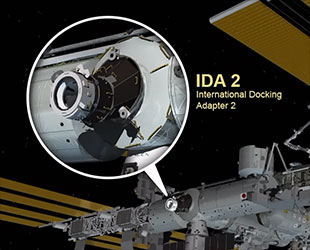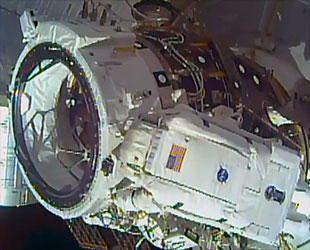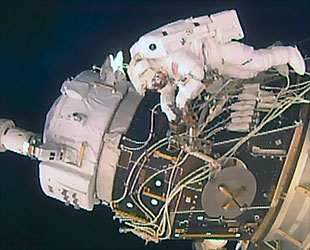August 19, 2016 — The International Space Station now has its first parking spot reserved for commercial vehicles.
Two NASA astronauts on Friday (Aug. 19) performed a six hour spacewalk outside the orbiting laboratory to install the docking ring, where Boeing and SpaceX crewed capsules will connect to the space station in the near future. Another of the international docking adapters (IDA) is planned to be launched in late 2017.
Expedition 48 commander Jeff Williams and flight engineer Kate Rubins oversaw the installation of the IDA on Friday, connecting power and data cables after the Canadian-built mulit-armed robot "Dextre" was used to position the IDA to latch onto the pressurized mating adapter where the space shuttles previously docked.
"This EVA [extravehicular activity] represents a significant milestone on the path to establishing a commercial crew capability on board the International Space Station, so we are very excited," said Kenny Todd, NASA's space station operations integration manager, at a press conference on Monday (Aug. 15). "We are very excited to put this piece of hardware on the front of the station and get it all integrated and get ready to go."

NASA graphic showing the installation location of the International Docking Adapter-2 (IDA-2) on the space station. (NASA TV) |
The IDA was launched inside the unpressurized trunk of the SpaceX Dragon cargo spacecraft that berthed to the space station on July 20. On Wednesday (Aug. 17), the Dextre special purpose dexterous manipulator, attached to the end of the Canadarm2 robotic arm, was used to extract the IDA from the Dragon and position it for installation on the forward end of pressurized mating adapter 2 (PMA-2).
Williams and Rubins began their spacewalk Friday at 7:04 a.m. CDT (1204 GMT). Just over an hour later, after they had configured their work stations, the Dextre released its grapple on the IDA, marking the first hand-off between the robot and spacewalking astronauts since the manipulator was added to the space station in 2008.
After the two astronauts cinched down the adapter using tethers, the 12 hooks used to hard mate the IDA to PMA-2 were driven closed at 9:40 a.m. CDT (1440 GMT), as was commanded by Japanese astronaut Takuya Onishi using a control panel inside the space station's Harmony node.
Williams and Rubins then set about connecting additional power and data cables, covering up an obsolete targeting reflector used by the space shuttle and installing two new reflectors on the adapter. The spacewalkers also removed a thermal cover from the front of the adapter, exposing the attachment point for in-bound commercial spacecraft.

Astronaut Jeff Williams works alongside the newly-installed IDA-2 outside the International Space Station on Aug. 19. (NASA TV) |
The IDA, which has an outer diameter of about 8 feet (2.4 m), will be the port to which SpaceX's Crew Dragon and Boeing's CST-100 Starliner commercial capsules will dock when bringing astronauts to the space station beginning in the next year or two. Built to a new international standard for docking systems, the IDA enables the different visiting vehicles to use the same port for automated berthings.
Future U.S. commercial cargo spacecraft and international spacecraft still to be designed may also use the IDA.
"It is amazing that now we have opened up a new chapter in the story of the International Space Station, putting the front door on this for future commercial vehicles," Williams radioed, "and, frankly, potential international vehicles that adopt the international standard that [the docking adapter] has been designed to."
Assembled by Boeing using parts from companies in 25 states, the adapter's primary structure was provided by the Russian aerospace company RSC Energia. The adapter's targets, used to guide spacecraft in for docking, are more sophisticated than earlier systems and include lasers and sensors that allow the station and capsules to talk to each other digitally to share distance cues and enable automatic alignment and connection.

Astronaut Kate Rubins configures a foot restraint early during her and Jeff Williams spacewalk to install the IDA. (NASA TV) |
Friday's spacewalk attached the IDA to PMA-2, one of the first two mating adapters launched to the space station in 1988 on STS-88, which was the first space shuttle mission to the infant orbital laboratory. Repositioned as the station grew in size, PMA-2 is connected to the forward end of the Harmony module.
The adapter installed on PMA-2, IDA-2, was the second to be built. The first IDA was destroyed in June 2015 with the launch failure of a SpaceX Dragon. A third IDA, now under construction by Boeing, is expected to be launched in late 2017 and attached to PMA-3 after that mating adapter is moved from the Tranquilly node to Harmony's zenith port.
Friday's EVA, which ended at 1:02 p.m. CDT (1802 GMT), five hours and 58 minutes after it began, marked the 194th spacewalk in support of the space station's assembly and maintenance. It was Williams' fourth career extravehicular activity and Rubins' first.
The 60th woman to fly into space, Rubins is now the 11th U.S. woman to perform an EVA and the 12th worldwide — including Soviet-era cosmonaut Svetlana Savitskaya, who was the first woman to spacewalk in 1984.
